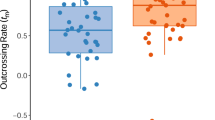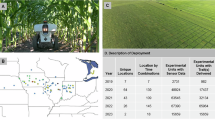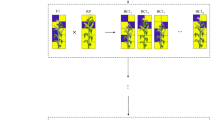Abstract
The mating system in an experimental population of rye (Secale cereale L.) cv. Merced was studied using eight polymorphic isozyme loci as genetic markers and two progeny samples from a large population: 20 emasculated mother plants (obligately cross-pollinating) and 100 non-emasculated mother plants. Merced rye showed a significant frequency of self-fertilization (s = 1 – t) in a previous generation, but in the generation under study the outcrossing frequency was not significantly different from t=1. This fact suggests that environmental factors can affect the rate of outcrossing vs. selfing (self-fertilization). In spite of the outcrossing rate of t = 1, the large progenies from emasculated plants (100 seeds per plant) demonstrated that pollination was not completely at random. This represents a violation of the generally accepted mixed-mating model on which most methods used to estimate mating parameters are based. Temporal heterogeneity and the differential ability of gametophytes to fertilize are possible causes of the non-randomness of mating. It is concluded that, although violations of the assumption of the mixed-mating model can bias the estimates, most of the estimated outcrossing values clearly differ from complete outcrossing.
Similar content being viewed by others
Article PDF
References
Allard, R W. 1975. The mating system and microevolution. Generics, 79, 115–126.
Bijlsma, R, Allard, R W, and Kahler, A L. 1986. Nonrandom mating in an open-pollinated maize population. Genetics, 112, 669–680.
Brown, A H D. 1989. Genetic characterization of plant mating systems. In: Brown, A. H. D., Clegg, M. T., Kahler, A. L. and Weir, B. S. (eds) Plant Population Genetics, Breeding and Genetic Resources, pp. 145–162. Sinauer, Sunderland, MA.
Clegg, M T, Kahler, A L, and Allard, R W. 1978. Estimation of life-cycle components of selection in an experimental plant population. Genetics, 89, 765–792.
Cruz-Pardilla, M, Vences, F J, Garcia, P, and Perez De La Vega, M. 1989. The effect of B chromosomes on outcrossing rate in a population of Secale céréale L. Heredity, 62, 319–325.
Farris, M A, and Mitton, J B. 1984. Population density, outcrossing rate and heterozygote superiority in ponderosa pine. Evolution, 38, 1151–1154.
Gertz, A, and Wricke, G. 1991. Inheritance of temperature-induced pseudocompatibility in rye. Plant Breeding, 107, 89–96.
Kahler, A L, Clegg, M T, and Allard, R W. 1975. Evolutionary changes in the mating system of an experimental population of barley (Hordeum vulgare L.). Proc Natl Acad Sci USA, 72, 943–946.
Kahler, A L, Gardner, C O, and Allard, R W. 1984. Non-random mating in experimental populations of maize. Crop Sci, 24, 350–354.
Marshall, D F, and Abboty, R J. 1984. Polymorphism for outcrossing frequency at the ray floret locus in Senecio vulgaris L. II Confirmation. Heredity, 52, 331–336.
Melz, G, Schlegel, R, and Thiele, V. 1992. Genetic linkage map of rye (Secale céréale L.). Theor Appl Genet, 85, 33–45.
Morgante, M, Vendramin, G G, and Olivieri, A M. 1991. Mating system analysis in Pinus leucodermis Ant.: detection of self-fertilization in natural populations. Heredity, 67, 197–203.
Nei, M. 1977. F-statistics and analysis of gene diversity in subdivided populations. Ann Hum Genet, 41, 225–233.
Perez De La Vega, M, and Allard, R W. 1984. Mating SVStem and genetic polymorphism in populations of Secale cereale and S. vavilovii. Can J Genet Cytol, 26, 308–317.
Ritland, K. 1983. Estimation of mating system. In: Tanksley, S. D. and Orton, T. J. (eds) Isozymes in Plant Genetics and Breeding, Part A, pp. 289–302. Elsevier Science, Amsterdam.
Schoen, D J, and Clegg, M T. 1986. Monte Carlo studies of plant mating system estimation models: the one-pollen parent and mixed mating models. Genetics, 112, 927–945.
Shaw, D V, Kahler, A L, and Allard, R W. 1981. A multüocus estimator of mating system parameters in plant populations. Proc Natl Acad Sci USA, 78, 1298–1302.
Trang, Q S, Wricke, G, and Weber, W E. 1982. Number of alleles at the incompatibility loci in Secale cereale L. Theor Appl Genet, 63, 245–248.
Vaquero, F, Vences, F J, Garcia, P, Ramirez, L, and Perez De La Vega, M. 1989. Mating system in rye: variability in relation to the population and plant density. Heredity, 62, 17–26.
Vaquero, F, Rebordinos, L, Vences, F J, and Perez De La Vega, M. 1990. Genetic mapping of isozyme loci in Secale cereale L. Theor Appl Genet, 80, 88–94.
Workman, P L, and Niswander, J D. 1970. Population studies on south-western Indian tribes. II. Local genetic differentiation in the Papago. Am J Hum Genet, 22, 24–49.
Wricke, G. 1979. Degree of self-fertilization under free pollination in rye populations containing a self-fertility gene. Z. Pflanzenzüchtung, 82, 281–285.
Acknowledgements
This study was supported by a grant from the Spanish Direccion General de Investigacion Cientifica y Tecnologica, PB88-0415.
Author information
Authors and Affiliations
Rights and permissions
About this article
Cite this article
Polanco, C., Gonzalez, C., Vences, F. et al. Non-random mating in a Secale cereale L. (rye) population. Heredity 72, 549–556 (1994). https://doi.org/10.1038/hdy.1994.75
Received:
Issue date:
DOI: https://doi.org/10.1038/hdy.1994.75
Keywords
This article is cited by
-
Biodiversity of Secale strictum in Iran measured using microsatellites
Genetic Resources and Crop Evolution (2011)
-
Genetic diversity of Secale cereale L. in Iran as measured using microsatellites
Genetic Resources and Crop Evolution (2010)
-
Analysis of the genetic diversity of wild Spanish populations of the genusHordeum through the study of their endosperm proteins
Plant Systematics and Evolution (1999)



